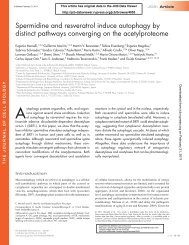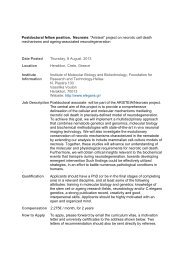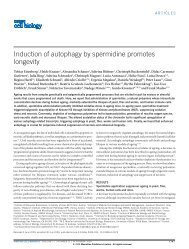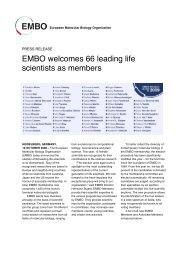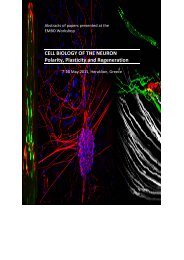Caenorhabditis Elegans - Tavernarakis Lab
Caenorhabditis Elegans - Tavernarakis Lab
Caenorhabditis Elegans - Tavernarakis Lab
Create successful ePaper yourself
Turn your PDF publications into a flip-book with our unique Google optimized e-Paper software.
This article was downloaded by:[HEAL-Link Consortium]<br />
On: 15 July 2008<br />
Access Details: [subscription number 772810551]<br />
Publisher: Informa Healthcare<br />
Informa Ltd Registered in England and Wales Registered Number: 1072954<br />
Registered office: Mortimer House, 37-41 Mortimer Street, London W1T 3JH, UK<br />
Journal of Neurogenetics<br />
Publication details, including instructions for authors and subscription information:<br />
http://www.informaworld.com/smpp/title~content=t713644816<br />
<strong>Caenorhabditis</strong> <strong>Elegans</strong> Degenerins and Vertebrate<br />
Enac Ion Channels Contain an Extracellular Domain<br />
Related to Venom Neurotoxins<br />
Nektarios <strong>Tavernarakis</strong> a ; Monica Driscoll a<br />
a Department of Molecular Biology and Biochemistry, Nelson Biological<br />
<strong>Lab</strong>oratories, Piscataway, NJ, USA<br />
To link to this article: DOI: 10.3109/01677060009084497<br />
URL: http://dx.doi.org/10.3109/01677060009084497<br />
Online Publication Date: 01 January 2000<br />
To cite this Article: <strong>Tavernarakis</strong>, Nektarios and Driscoll, Monica (2000)<br />
'<strong>Caenorhabditis</strong> <strong>Elegans</strong> Degenerins and Vertebrate Enac Ion Channels Contain<br />
an Extracellular Domain Related to Venom Neurotoxins', Journal of Neurogenetics,<br />
13:4, 257 — 264<br />
PLEASE SCROLL DOWN FOR ARTICLE<br />
Full terms and conditions of use: http://www.informaworld.com/terms-and-conditions-of-access.pdf<br />
This article maybe used for research, teaching and private study purposes. Any substantial or systematic reproduction,<br />
re-distribution, re-selling, loan or sub-licensing, systematic supply or distribution in any form to anyone is expressly<br />
forbidden.<br />
The publisher does not give any warranty express or implied or make any representation that the contents will be<br />
complete or accurate or up to date. The accuracy of any instructions, formulae and drug doses should be<br />
independently verified with primary sources. The publisher shall not be liable for any loss, actions, claims, proceedings,<br />
demand or costs or damages whatsoever or howsoever caused arising directly or indirectly in connection with or<br />
arising out of the use of this material.
Downloaded By: [HEAL-Link Consortium] At: 15:54 15 July 2008<br />
J. ,Vc,en,y~~ia~rb,. Vol. 13(41, pp. 257-264<br />
Reprints availahle directly froin the puhlishrr<br />
Photocopying permitted hy license only<br />
Short Communication<br />
I<br />
2000 OPA (Oversees Puhli,hers Association) N.V<br />
Puhhhcd by license under<br />
the Haraood Academic Puhlishers imprint.<br />
part of The Gordon and Breach Publishing Group.<br />
Printed in Mnlayw<br />
CAENORHABDITIS ELEGANS<br />
DEGENERINS AND VERTEBRATE<br />
ENaC ION CHANNELS CONTAIN AN<br />
EXTRACELLULAR DOMAIN RELATED<br />
TO VENOM NEUROTOXINS<br />
NEKTARIOS TAVERNARAKIS* and<br />
MONICA DRISCOLL<br />
Departriirnt of' Molecirlar Biologv arid Biocheniistrj3, Nelsori Biologicid<br />
<strong>Lab</strong>oratories. 604 AIlisori Rout!, Rirtgrrs Uiiiwrsiry.<br />
Piscatawr~, NJ 08855, USA<br />
The DEG, ENaC (DEGenerin~Epithelial Na+ Channel) superfamily includes closely<br />
related ion channel subunits from divergent species ranging from the simple nematode<br />
C'c~e~iorhtch~~iris dc,gciri.s to humons. Members of this protein group play roles in SWKWI<br />
important processes including transduction of mechanical stimuli, sodium re-absorption<br />
and blood pressure regulation. Structure,'function relationships in members of this<br />
superfamily are just beginning to be elaborated. Using a bioinformatics approach. we<br />
identified ii novel structural element in the extracellular region of DEG;ENuC proteins<br />
that exhibits significant similarity to venom neurotoxins. Since venom neurotoxins<br />
bind to sodium channels at high affinity. we suggest that the related domain embedded<br />
in DEG,ENaC channels may interact with other regions of the channel or channel complex<br />
to modulate channel function.<br />
Kf,wwth; Mechanotransduction: neurodegKnKratiOn:<br />
Kunitz-type protease inhibitors: anti-epilepsy peptide<br />
*Corresponding author. Tel.: (732)-445-7187. Fax: (7323-445-4213,<br />
E-mail: tavernarakisiLr mbcl.rutgers.edu.
258 N. TAVERNARAKIS AND M. DRISCOLL<br />
Downloaded By: [HEAL-Link Consortium] At: 15:54 15 July 2008<br />
INTRODUCTION<br />
Cell volume regulation, gravitaxis, proprioception, touch sensation,<br />
and auditory transduction all depend on the conversion of mechanical<br />
energy into cellular responses (reviewed in Sackin, 1995). Still, little is<br />
known about the molecular properties of ion channels specialized for<br />
mechanotransduction. Genetic studies in the nematode Curnorkubciitis<br />
cleguns led to the identification of several genes that encode subunits<br />
of candidate mechanically-gated ion channels involved in mediating<br />
touch transduction, proprioception and regulation of locomotion<br />
(Driscoll and Chalfie, 1991 ; Huang and Chalfie, 1994; <strong>Tavernarakis</strong><br />
et ul., 1997). These channel subunits belong to a large family of related<br />
proteins in C. elegcins referred to as degenerins, because unusual gainof-function<br />
mutations in several family members induce swelling or cell<br />
degeneration (Driscoll and Chalfie, 1991 ; <strong>Tavernarakis</strong> and Driscoll,<br />
1997). C. ekegrins degenerins exhibit approximately 25-30% sequence<br />
identity to subunits of the vertebrate amiloride sensitive epithelial Na+<br />
channels (ENaCs; Chalfie et al., 1993), which are required for ion<br />
transport across epithelia (reviewed in Palmer, 1992). Together the<br />
C. e1epn.s and vertebrate proteins define the DEG/ENaC (degenerin/<br />
epithelial sodium channel) superfamily of ion channels (Corey and<br />
Garcia-Aiioveros, 1996). Members of the DEG/ENaC superfamily are<br />
characterized by two transmembrane domains and two cysteine-rich<br />
domains (CRDs) (CRDII and CDRIII); an additional CRD, CDRI is<br />
present only in nematode degenerins. DEG/ENaC proteins are localized<br />
in the plasma membrane with both amino- and carboxy-termini<br />
projecting inside the cell and a large region that includes the CRDs<br />
situated on the extracellular side (Canessa CI a/., 1994; Lai PI d., 1996).<br />
The high degree of sequence conservation observed within specific<br />
extracellular segments of DEG/ENaC superfamily members implies<br />
that these domains may contribute to an important, currently<br />
undetermined function. We took a bioinformatics approach to investigate<br />
the possibility that these domains comprise essential structural<br />
elements, not necessarily confined to this category of ion channels.<br />
The presence of similar sequence segments in other protein groups<br />
suggests a common function and may provide a hint as to what purpose<br />
these domains serve in the extracellular region of DEG/ENaC<br />
proteins.
DEGENERINS AND ENaC ION CHANNELS 259<br />
Downloaded By: [HEAL-Link Consortium] At: 15:54 15 July 2008<br />
MATERIALS AND METHODS<br />
Sequences<br />
Accession numbers for the toxin sequences analyzed are: AEP-MES-<br />
MA: P15228, SCXC-CENLL: P45667, SCXI-CENSC: PO1491.<br />
SCX I-CENSC: P01492, SCX2-CENSC: P01493, SCXI-CENNO:<br />
PI 5223. SCX7-CENNO: P45665, NTSR IC: g69540. Accession numbers<br />
for members of the DEG/ENaC superfamily are DEL-1: U76403,<br />
MDEG: U53211, MEC-4: U53669. MEC-10: P34886, UNC-8: U76402,<br />
arENaC: X70497, OrENaC: X77932, yrENaC: X77933.<br />
Database Mining<br />
The Blockmaker algorithm (Henikoff et al., 1995; Henikoff and<br />
Henikoff, 1991) was run on the Blocks Server web site: (http://<br />
blocks.fhcrc.org/). Blocks identified were subjected to Multiple EM<br />
for Motif Elicitation algorithms (Timothy and Elkan, 1994: Timothy<br />
and Gribskov, 1998) run on the Multiple Expectation Maximization<br />
for Motif Elicitation (MEME) System, web based, server (http://<br />
www.sdsc.edu/MEME/meme/website/). BLAST searches (Altschul<br />
eta/., 1997) were performed with the National Center for Biotechnology<br />
Information web based servers (NCBI; http://www.ncbi.nlm.nih.gov/<br />
BLAST/).<br />
Alignments<br />
Multiple sequence alignments were generated with the ClustalW algorithm<br />
(Thompson et a/., 1994) and displayed with SeqVu (The Garvan<br />
Institute of Medical Research, Sydney, Australia).<br />
RESULTS AND DISCUSSION<br />
To scan for conserved motifs within DEG/ENaC superfamily members,<br />
we applied the Blockmaker algorithm (Henikoff et a/., 1995: Henikoff<br />
and Henikoff, 1991) on a group of eight representative protein<br />
sequences (DEL-I, MDEG, MEC-4, MEC-10, UNC-8, crrENaC,
760 N. TAVERNARAKIS AND M. DRISCOLL<br />
Downloaded By: [HEAL-Link Consortium] At: 15:54 15 July 2008<br />
Ih-ENaC, yrENaC). Six conserved amino acid sequence blocks were<br />
identified in the eight sample proteins (not shown). Based on these<br />
blocks, a position-specific scoring matrix was generated and used to<br />
search protein databases for sequences that contain one or more of the<br />
six identified motifs. The MEME system was employed for these<br />
database searches (Timothy and Elkan. 1994; Timothy and Gribskov,<br />
1998). As expected this scan detected all the sequences of DEG/ENaC<br />
superfamily members documented in the databases. Interestingly, several<br />
short venom neurotoxin sequences were additionally detected that<br />
shared significant similarity with a region which partially overlaps with<br />
CRDII of both mammalian and C. c/ijgcm.s DEG/ENaC superfamily<br />
members (we refer to this as the Geurotoxin-related domain NTD; see<br />
Fig. 1). To further explore this similarity we generated a multiple<br />
sequence alignment between the eight channel protein sequences that<br />
were used as probe for the described searches and a representative<br />
sample ofeight of the neurotoxin sequences detected, with the ClustalW<br />
algorithm (Thompson ct id., 1994). As shown in Fig. IA the short<br />
neurotoxin sequences align to the channel sequences in and around<br />
CRDlll with six of the eight conserved cysteine residues of neurotoxins<br />
preserved in DEG/ENaC superfamily members. However. the overall<br />
similarity between the two groups of protein sequences appeared to be<br />
low. This low level of similarity did not allow detection of one of the two<br />
protein groups in BLAST searches (Altschul Pt d., 1997). with the other<br />
group used as query. Therefore, we assessed the statistical significance<br />
of the similarity by generating blocks from both groups of sequences<br />
and aligning them with ClustalW. The blocks aligned with a p-value of<br />
1.92e-07 (not shown). Next, the quality of the alignment was calculated<br />
to a p-value of 1.76e-05 using the FASTA package PRSS3 algorithm<br />
(Pearson, 1990) to uniformly shuffle the sequences. We concluded that<br />
there is a low but significant level of sequence similarity between an<br />
extracellular region of DEG/ENaC proteins and certain neurotoxins.<br />
A few points regarding this sequence similarity are noteworthy. First,<br />
it is interesting that all of the detected neurotoxins belong to the beta<br />
subfamily of scorpion venom toxins, with only the anti-epilepsy peptide<br />
(AEP-MESMA), representing an alpha-type neurotoxin. This bias for<br />
specific detection strengthens the significance of the similarity between<br />
these toxins and DEG/ENaC channels, as other types of toxins with<br />
preponderance of closely spaced cysteine residues are not detected.
A MEC-10<br />
MEC-4<br />
DEL-1<br />
UNC-8<br />
aiENaC<br />
PrENaC<br />
yENaC<br />
MDEG<br />
SCXZCENSC<br />
NTSRIC<br />
SCXlLCENNO<br />
SCX7.CENNO<br />
SCXILCENSC<br />
SCXlLCENSC<br />
SCXC-CENLL<br />
AEP-MESMA<br />
B<br />
MSDl CRDl CRDll CRDlll MSDll<br />
I I coon<br />
Extracelluler region<br />
FIGURE 1 Similarity of neurotoxins to a DEG:ENaC ion channel domain. (A) Amino acid alignment of eight DEG:ENaC superfamily members<br />
and eight venom neurotoxins. Identical residues that occur in more than 60% of the sequences are boxed. Gray-shaded residues represent sequence<br />
similarity (> 85%; for homology analysis the first sequence is used as primary. i.e. homology is displayed with respect to MEC-I0 sequence). Residue<br />
positions are noted on both sides of the alignment for each of the designated sequences. Representative members of the DEG,:ENaC superfamily<br />
characterized to-date were included in the alignment (without orthologs in different species). Anti-epilepsy peptide (AEP-MESMA) helongs to the<br />
alpha subfamily of neurotoxins while the remaining seven toxin sequences are typical of the beta class. (B) Schematic representation of DEG. ENaC<br />
ion channel subunit structure. The position of the toxin-related region is shown with respect to other characteristic features of the channel (NTD;<br />
depicted by the wavy-line shaded rectangle). Defined channel modules are indicated by shaded hoses. These include the two membrane spanning<br />
domains (MSDs: dark-dotted shading), and the three CRDs (CRDs: thick-line shading; the first CRD is absent in mammalian channels and is<br />
depicted by thin-line shading). The small light-dotted oval depicts the putative extracellulur regulatory domain (ERD) identilied by Garcia-Afioveros<br />
and co-workers in C. c/cgum degenerins (Garcia-Aiioveros CI d.. 1995).<br />
Downloaded By: [HEAL-Link Consortium] At: 15:54 15 July 2008
262 N. TAVERNARAKIS AND M. DRISCOLL<br />
Downloaded By: [HEAL-Link Consortium] At: 15:54 15 July 2008<br />
In addition, DEG/ENaC superfamily members are the only channels<br />
that exhibit similarity to venom neurotoxins. Second, NTD is also<br />
distantly related to domains in several other proteins including the<br />
Drosopkilu crurnhs protein, required for epithelial organization (Tepass<br />
et ul., 1990), ugrin, a basal lamina protein that mediates aggregation of<br />
acetylcholine channels (Rupp et d., 1992). and the selectins which<br />
participate in cell adhesion (such as ELAM-I; Bevilacqua et a/., 1989).<br />
Both alpha and beta type neurotoxins identified contained Kunitz-type<br />
basic protease inhibitor motifs. However, the Kunitz domain signature<br />
is not intact in the NTD of DEG/ENaC ion channels. Nevertheless,<br />
amino acid sequence similarity spans the entire length of the toxins (an<br />
average of 65 amino acid residues). Third, the preserved arrangement of<br />
cysteines in such sequences could dictate similar higher structures in the<br />
corresponding protein domains. However, although the structure of<br />
several neurotoxin peptides is known (Zlotkin et al., 1991), such<br />
information is not available for any of the DEG/ENaC proteins.<br />
The noted similarities also hold intriguing implications for the<br />
function of these domains and channel biology. First, since it is known<br />
that venom neurotoxins are potent and specific blockers of Na’ channels<br />
(Zlotkin et ul., 1991; Becerril et ul., 1993), it is possible that a related<br />
domain embedded within a channel protein could regulate channel<br />
activity. Interestingly, a region close to NTD has been implicated in<br />
closing of C. efeguizs DEG-I and MEC-4 degenerin channels (ERD for<br />
- extracellular regulatory domain; see Fig. I; Garcia-Aiioveros et ul.,<br />
1995). The boundaries of this domain have not been experimentally<br />
delineated and might therefore extend into NTD. Further evidence<br />
supporting an intra-channel regulatory activity mediated by an extracellular<br />
channel domain comes from a channel-activating mutation in<br />
the C. elegans UNC-8 proprioception channel, which also maps to the<br />
NRD region (<strong>Tavernarakis</strong> et ul., 1997).<br />
Second, and more generally, venom neurotoxins bind with high<br />
affinity to Na+ channels which implicates the venom-like domain within<br />
DEG/ENaC channels in high affinity interactions. Domains that<br />
facilitate such high affinity interactions are thought to be essential for<br />
tethering mechanically-gated channels to “molecular springs” that<br />
deliver required gating tension. It is intriguing that some mutations that<br />
disrupt MEC-4 function, map to the NTD (K. Hong and M. Driscoll,<br />
unpublished observations), further suggesting that this region is
DEGENERINS AND ENaC ION CHANNELS 263<br />
Downloaded By: [HEAL-Link Consortium] At: 15:54 15 July 2008<br />
functionally significant. The presence of similar domains in other proteins<br />
such as crunrhs and ugrin implies that such domains might act as<br />
interaction modules that mediate analogous interactions needed for tissue<br />
organization or protein clustering. We hypothesize that the appearance<br />
of neurotoxin related domains in a specific class of ion channels<br />
might be the result of convergent evolution, driven by the requirement<br />
for high affinity interaction modules in these proteins.<br />
Acknowledgments<br />
Research was supported by grants from the National Science Foundation<br />
(IBN-9511710) and National Institutes of Health (NS34435,<br />
NS37955). M.D. is a fellow of the Alfred P. Sloan Foundation, N.T. is<br />
supported by Human Frontiers in Science Program Organization<br />
Research Fellowship.<br />
References<br />
Altschul, S.F., Madden, T.L., Schaffer, A.A., Zhang, J.Z., Miller, W. and Lipman, D.J.<br />
(1997). Gapped BLAST and PSI-BLAST: a new generation of protein database<br />
search programs. Nuc. Acids Rt’s., 25, 3389-34011.<br />
Becerril. B., Vazquez. A., Garcia, C., Corona, M., Bolivar, F. and Possani, L.D. (1993).<br />
Cloning and characterization of cDNAs that code for Na( + )-channel-blocking<br />
toxins of the scorpion Cetitruroide.s ~
264 N. TAVERNARAKIS AND M. DRISCOLL<br />
Downloaded By: [HEAL-Link Consortium] At: 15:54 15 July 2008<br />
Lai, C.C., Hong. K.. Kinnell, M., Chalfie. M. and Driscoll, M. (1996). Sequence and<br />
transmembrane topology of M EC-4. an ion channel subunit required for mechnnotransduction<br />
in C. c+gtriis. J. CeN. Bid., 133. 1071- 1081.<br />
Palmer. L.G. ( 1992). Epithelial Nil+ channels: function and diversity. A/iriu. Rev. P/iy.~io/..<br />
54. 51-66.<br />
Pearson. W.R. (1990). Rapid and sensitive sequence comparison with FASTP and<br />
FASTA. Mt,//~~tl.c i/r E/i:.~wio/o~rI~. 183. 63-98.<br />
Rupp. F.. Ozcelik, T., Linial, M.. Peterson. K.. Francke, U. and Scheller. R. (1992).<br />
Structure and chromosomal localization of the mammalian ugh gene. J. Ncirro.rc,i..<br />
12.3535-3544.<br />
Sxkin. H. (1995). Mechanosensitive channels. Amii. RPI.. Ph~~sid.. 57. 333-353.<br />
<strong>Tavernarakis</strong>. N. and Driscoll. M. ( 1997). Molecular modeling of niechanotransduction<br />
in the nematode C‘trc,ii~~rlitrht/iric. ~4ymr.r. .4/1nir. Rn.. P/ij~i(~/.. 59. 659-689.<br />
<strong>Tavernarakis</strong>. N.. Shreffler. W.. Wang. S.L. and Driscoll, M. (1997). irric-X. a member of<br />
the DEG, ENaC superfmnily, encodes it subunit of a candidate stretch-gated motor<br />
neuron channel that inodulatcs locomotion in C. dqtrti.s. Ntwori. 18, 107- I 19.<br />
Tepass. U.. Thews. C. and Knust, E. (1990). [w//d).v encodes ;in EGF-like protein<br />
expressed on apical membrnnes of ~r(~so/~/ii/r epithelial cells and required for organizttion<br />
of epithelia. C’o//. 61. 787-799.<br />
Thompson. J.D.. Higgins. D.G. and Gibson. T.J. (1994). CLUSTAL W: improving<br />
the sensitivity of progressive multiple sequence alignment through sequence weighting.<br />
positions-specific gap penalties and weight matrix choice. Nirc.. ilcids RcJ.. 22.<br />
4673-4680.<br />
Timothy. L.B. and Elkan. C. (1994). Fitting a mixture model by expectation maximization<br />
lo discover molifs in hiopolymers. In Procwr/iri,qs o/’ llir SWO/I~/ !/iforri[r/ioiit//<br />
Co/i/i~r~viw<br />
Iritt4/i,ycvir Sw/cwi.\ /or hfo/twr/tir Bid~,y~. (Menlo Park. Cnlifornio:<br />
AAAl Press). pp. 28-36.<br />
Timothy. L.B. and Cribskov, M. (I 99X). Combining evidence using p-values: application<br />
to sequence homology seurches. Bioiri/or/,itrtic..r. 14. 48-54.<br />
Zlotkin. E.. Eitan. M.. Bindokas. V.P., Adams. M.E.. Moyer. M., Burkhart, W. and<br />
Fowler. E. (1991 ). Functional duality and structural uniqueness ofdepressant insectselective<br />
neurotoxins. Bi~~c,/i~,/iii.s/r~.. 30. 48 14-4x2 I ,



